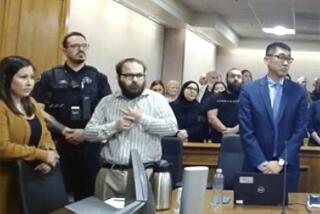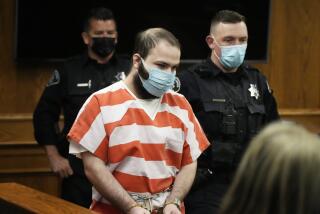Mental state likely to be key in Santa Cruz fatal stabbing case
SANTA CRUZ — After months spent in a state mental hospital, Charles Anthony Edwards was brought Monday to a Santa Cruz County courtroom, where a judge will determine whether he should be tried in a slaying that shocked this beach town.
Edwards’ public defender conceded during the first day of an expected two-day preliminary hearing that his client had been identified by two witnesses to the stabbing of downtown business owner Shannon Collins.
The stocky 44-year-old Edwards was arrested not far from the street where Collins fell, her right carotid artery and jugular vein slashed. According to testimony by the arresting officer, there was blood spattered on Edwards’ head and shoes when he was stopped by police.
“This is not an ID case,” Assistant Dist. Atty. Celia Rowland said.
What most likely will be at issue is Edwards’ mental state at the time and the circumstances of his release from the same mental hospital — not long before Collins’ May 7, 2012, slaying — due to a clerical error by a state corrections employee.
Edwards has a history of delinquency and mental illness dating to age 13, including a violent assault on his mother. Over the last 22 years, he cycled through state mental hospitals 10 times and prison-based psychiatric programs seven times, documents show.
At Atascadero State Hospital before the slaying, he was classified as a mentally disordered offender — a parolee deemed too dangerous for release due to active mental illness. Yet in September 2011, the facility sent him to a highly monitored conditional-release program in Manteca for a taste of freedom.
Edwards lasted only a week before begging to go back, family members said.
After a brief stint at Napa State Hospital, he was rereleased to the same program. That time he lasted two weeks before telling his brother he was afraid he couldn’t make it on the outside, according to records and interviews.
At a Napa State Hospital hearing that November, officials from the California Department of Corrections and Rehabilitation and the Department of State Hospitals agreed, determining Edwards should remain confined. He was shipped back to Atascadero the following month.
But the date for his mandatory one-year parole review was entered into the system incorrectly. Officials acknowledged to The Times last year that the deadline came and went unnoticed.
Officials had a number of options at their disposal to extend Edwards’ confinement, but once the date had passed, there was no legal way to hold him. On Jan. 10, 2012, he was driven by an Atascadero staff member to the bus station in Paso Robles, according to a document recently obtained by The Times. It said: “Destination, SF.”
Edwards drifted from San Francisco to his brother’s Central Valley home and eventually to Santa Cruz. He told family he had stopped taking his psychiatric medication. After holing up in a homeless shelter with a Bible and mumbling to himself for four days, he attacked Collins as she walked to a hair appointment.
Edwards was deemed incompetent to stand trial last year and sent back to Atascadero to be stabilized. He sat in court Monday — medicated and shaking sporadically — in an orange-and-white-striped jail suit, shackled at the wrists.
During the hearing, Deputy Public Defender Anthony Robinson sought to highlight Edwards’ demeanor in the aftermath of the stabbing. He presented a video of a seemingly disengaged Edwards, falling asleep in the back of a patrol car just after his arrest. Robinson said he was reviewing Edwards’ mental health records and may contemplate a plea of not guilty by reason of insanity.
As for Edwards’ botched release, Robinson said: “It’s not an excuse for what happened, but it helps to explain more about why, and we’re definitely looking into that.”
Rowland, meanwhile, on Monday argued that Edwards belongs in prison for life, not in a mental hospital. “I think there’s plenty of evidence that he understood the difference between right and wrong — both morally and legally,” she said.
Collins, 38, was a smiling presence in the small downtown boutique she ran with her husband, Kenneth Vinson. He has filed a lawsuit against the Department of Corrections as well as the state hospitals, alleging that officials “knew that Edwards continued to suffer from a severe mental disorder during the period of his parole.”
Edwards’ release, the lawsuit noted, was exactly the situation the state Legislature had sought to avoid when crafting the laws governing mentally disordered offenders.
The state attorney general’s office is seeking to have the lawsuit thrown out, citing government immunity from liability.
[For the Record, 8:04 a.m. PDT Aug. 6: An earlier version of this article carried a headline stating that a judge will determine whether Charles Edwards is mentally fit to stand trial. He has already been deemed mentally fit to stand trial. The judge presiding over his preliminary hearing will determine whether evidence of culpability is sufficient to move forward with a criminal trial. The question of whether he was legally insane at the time of the slaying might become an issue at that trial.]
More to Read
Sign up for Essential California
The most important California stories and recommendations in your inbox every morning.
You may occasionally receive promotional content from the Los Angeles Times.











